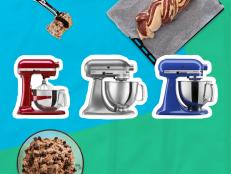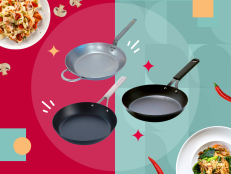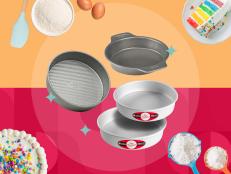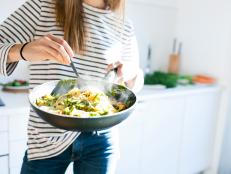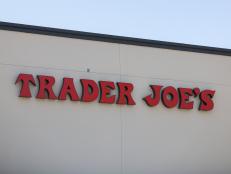How to Tell the Difference Between a Sauté Pan and a Saucepan
Using the right pan in the kitchen makes all the difference.

Tim M Lanthier/Getty Images
It’s an all-too familiar feeling; you’re about to finally try that new recipe, you open your cupboard to get started, and you immediately wonder, “which pan I should use for this recipe?!” It happens to the best of us, especially when there are a few pans that may seem pretty similar, like sauté pans and saucepans.
While sauté pans and saucepans do have a lot in common, they also have stark differences including shapes, sizes and uses, and deciding which pan to use could make all the difference in your cooking. It may seem a bit intimidating, but never fear we’re here to tell you everything you need to know about these two classic kitchen staples.
What is a Sauté Pan?

Jupiterimages/Getty Images
A sauté pan, which is often confused with a curved-edge skillet, can be distinguished by its large base with straight, vertical edges that form a right angle. Saute pans have a large handle for usability and always come with a lid. They’re typically sized in volume, with the most common sizes being somewhere in the 3-to-6-quart range. The large base takes on searing and browning like a pro, and the sides are tall enough to handle a decent amount of liquid. The design allows for both dry heat (think searing a steak or sautéing veggies) and liquid cooking (these are your braised chicken thighs or deep-fried onion rings).
Saute pans come in a variety of materials and finishes, including stainless steel, enameled cast-iron, copper, aluminum and non-stick. Sauté pans are ideal for cooking dishes that go from stove to oven as needed. But, it’s important to note that non-stick finishes are not oven-safe, so a fully stainless steel pan is the best option for those recipes and will give you the most opportunities for use. Overall, sauté pans are one of the most versatile pans out there with a unique range of possibilities. They can take on everything from a frittata and curry to braised short ribs, and you are sure to get years of use on many recipes with one of these pans in your kitchen supply.
What is a Saucepan?
Saucepans have their own unique design features that make them a must-have in any kitchen. They have a smaller base with taller, vertical edges that also form a right angle. But these taller edges mean saucepans are perfect for holding liquids. They’re the right choice for gravies, small-batch jams, boiling water, caramel and, of course, sauces. Saucepans are measured in volume, typically coming in sizes ranging from 2-to-4 quarts, and they usually come with a lid. They also have a long handle, which makes them very easy to maneuver while whisking or stirring whatever you are cooking. Since they’re in that smaller size range, you won’t be making big batches of stock or tomato sauce for a crowd in your saucepan, but they are perfect for a bit of stewed lentils or a poached egg. They come in many different materials and finishes, including stainless steel, aluminum, copper, and non-stick. You probably won’t be using your saucepan in the oven, since its core uses all happen on the stove, so the right material for the pan comes down to preference. Choose whatever material makes you the most comfortable and confident cook over your stove. Saucepans are a classic kitchen staple you will use over and over again.
Sauté Pan vs. Saucepan
These two pans do have quite a bit in common, but the nuances of their differences will be crucial when deciding which to use. They both have those straight vertical sides coming off the base, but sauté pans have shorter sides and saucepans have taller sides. With a larger base, sauté pans are arguably more versatile than saucepans, since you can make such a wide range of sautéed and braised dishes in them, such as sautéed mushrooms, braised chicken thighs and apples, salmon with lentils and onion jam. Saucepans still have their place though. They’re your go-to for dishes that focus more on liquid, including herbed quinoa, brown gravy, hard boiled eggs, beurre blanc and one-pot mac ‘n’ cheese. Sometimes these two pans can even be used interchangeably, if you’re making something that includes light sautéing and liquid cooking, such as marinara sauce or stewed okra and tomatoes.
Which of these pans should you have in your kitchen? The answer is that they both have their respective places in your cookware collection. They may have many similarities, but they are two very different pans, each with a wide range of versatility. They will quickly become your two of your most-used pans.
Related Links:

































